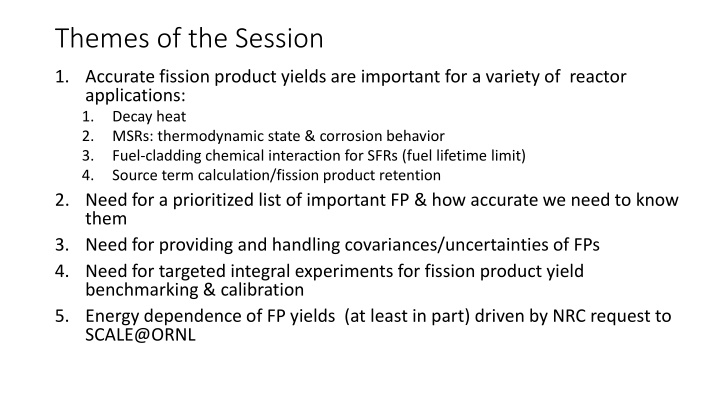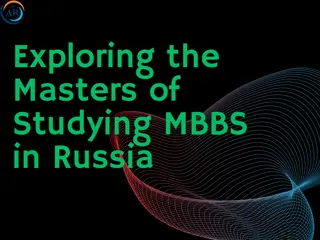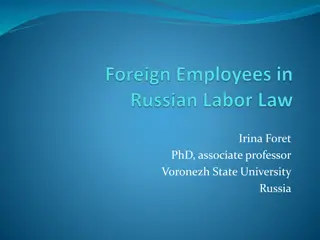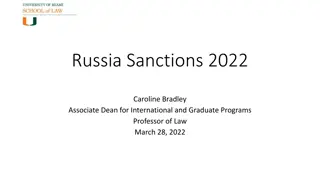Brief History of Russia: Tetris & Beyond
Russia, the largest European country, rich in natural resources, with a complex history of tsars, revolutions, and regime changes leading to the Soviet Union era. Explore the Russian context, from the autocracy of the tsars to Lenin's communist regime, and delve into the challenges faced by this vast multiethnic state.
Download Presentation

Please find below an Image/Link to download the presentation.
The content on the website is provided AS IS for your information and personal use only. It may not be sold, licensed, or shared on other websites without obtaining consent from the author.If you encounter any issues during the download, it is possible that the publisher has removed the file from their server.
You are allowed to download the files provided on this website for personal or commercial use, subject to the condition that they are used lawfully. All files are the property of their respective owners.
The content on the website is provided AS IS for your information and personal use only. It may not be sold, licensed, or shared on other websites without obtaining consent from the author.
E N D
Presentation Transcript
Themes of the Session 1. Accurate fission product yields are important for a variety of reactor applications: 1. Decay heat 2. MSRs: thermodynamic state & corrosion behavior 3. Fuel-cladding chemical interaction for SFRs (fuel lifetime limit) 4. Source term calculation/fission product retention 2. Need for a prioritized list of important FP & how accurate we need to know them 3. Need for providing and handling covariances/uncertainties of FPs 4. Need for targeted integral experiments for fission product yield benchmarking & calibration 5. Energy dependence of FP yields (at least in part) driven by NRC request to SCALE@ORNL
Presentation 1: Overview of LWR and Advanced Reactor Fuel Forms, Speaker: Sebastian Schunert. The talk introduced different reactor fuel forms, with the goal of highlighting engineering problems arising from fission products. Examples: Xenon pit, fission-cladding-chemical-interactions, and TRISO fission product retention. These examples highlighted the need of knowing fission product yields in nuclear engineering design and operation of reactors. Q/A: First set of questions focused on decay heat. What is the most pressing need? Speaker answered that advanced reactors have no standards for decay heats like light water reactors. The NRC/SCALE representative [Will Wiesequist] noted that using the full SCALE list of isotopes, good agreement to decay heat benchmarks for advanced reactors are obtained. However, the lack of reliable computationally efficient standards was noted. A concern was raised about computing displacement per atom (DPA) in nuclear reactor. The speaker noted that DPA for material degradation analysis do not need to be very accurate. However, a comment from the audience noted that stopping powers are poorly understood and DPA estimates are poor because of it.
Presentation 2: Importance and Needs for Fission Product Yields in Neutronics and Regulatory Analysis for Nuclear Reactors. Speaker: Jesse Brown The talk focused on the capabilities of SCALE's "Oak Ridge Isotope Generation code" (ORIGIN) which is: irradiation and decay simulation code for general purpose isotopic inventory. Application of ORIGIN include isotopic inventories, source terms, and decay heat. ORIGIN s accuracy is limited by the accuracy of the nuclear data (decay data, cross sections, gamma-ray production data, fission product yields). Examples for isotopic abundance in spent nuclear fuel and decay heat benchmarks were provided. The need for covariances was highlighted in the talk: "New capabilities with covariance data should be developed", "V&V methods and analysis also needed for the covariance data". Q/A What is the plan for moving FY covariances into ENDF? What validation methods should we focus on?
Presentation 3: Importance and Needs for Fission Product Yields in Molten Salt Reactor Chemistry and Corrosion Modeling, Speaker: Mauricio Tano The talk described the importance of fission yields for Molten Salt Reactors (MSRs) (more precisely: reactors where the fuel is dissolved in the coolant). Corrosion: uncertainty in FY leads to large uncertainty in the charge density. Charge density drives corrosion behavior of the reactor and corrosion is one of the major issues with MSRs. For fluoride salts the uncertainty in charge density at 100 MWd/kg is 100%. For chloride salts, similar uncertainties are present, but the behavior can change qualitatively between reducing and oxidizing. This is problematic because the engineering countermeasures against reducing and oxidizing conditions are completely different. Fission yield uncertainties also have a sizeable impact on off-gas concentrations. Reduction in uncertainties on fission yields will have a large impact on predicting chemical behavior of MSRs. QA: What target accuracy is needed [for the chemistry calculations]? Answer: 10 %. It remains to be investigated which isotopes drive the uncertainties. Fission yield covariances were determined using a simplified model. Their actual impact remains to be investigated.
Accident Source Terms, Speaker: David Luxat The talk focuses on the impact and importance of fission product yields on severe accidents and severe accident modeling. The talk highlighted the fact that fission products vary in their radio- biological importance, their transport/adsorption, and dispersion behavior. Sandia's Melcor code predicts radiological release during severe accidents by starting from SCALE-computed fission product inventories and then applying in-core and ex-core transport models. Melcor models directly inform the NRC about radiological release vectors for current and advanced nuclear reactors.
Presentation 5: Importance and Needs for FPY for fluid properties in MSRs Speaker: Theodore Bessman Salt compositional information are essential for characterizing thermodynamic equilibrium state & fluid properties of molten salt fuel These information are needed in multiphysics codes developed by the nuclear energy advanced modeling and simulation (NEAMS) program (neutronics & thermal-hydraulics design & safety analysis) NEAMS & MSR programs develop thermo-chemical and thermo-physical databases. Fundamental material systems [pure salts] are contaminated by fission products and to predict the level of contamination we need to know FPYs Example: changes in compositions drive changes of the temperature where first precipitation of solids happen [Note: undesired phenomenon] The influence of uncertainties on vapor pressures (and this source term) of fission products is demonstrated to be large (50% variation leads to a change of an order of magnitude in vapor pressure) If you do not have a good understanding of fuel salt content, then you cannot classify the source term well
How can integral benchmarks benefit fission product data via data calibration Speaker: Daniel Siefmann The main theme of this talk is how integral benchmarks can benefit fission product yield data via data calibration. Post Irradiation Examinations are the most sensitive experiments to fission product yields. Simulation biases and uncertainties on fission product inventories are large for models of integral experiments. The proposed method shows reduction in bias and uncertainties by a factor of 2 and generalizes to unseen but rather similar data [two different fuel rods in PWR and a comparison was done between them - from clarification on Q/A]. Recommendation for Ideal Integral Experiment: well characterized neutron source & fissile target high precision fission product analysis (chemical dissolution and mass spectrometry) detailed computational model with relevant uncertainties QA: Fast burners have extremely well qualified neutron spectra, but no data seems to be available. Lack of experimental data was noted again. Response by speaker: there needs to be a lot more work done in this area. There is some work being done by Idaho National Laboratory. Interjection from the audience: there is active research trying to address this problem, one is activation analysis. However, it's very hard to pull apart fission yield fragments under 1 MeV, without time of flight info, how can it work? [I think the comment was about quantifying spectra in reactors]. INL radiochemistry does it at MFC, but its very expensive. [I believe a comment where PIE is or could be done]
Covariance requirements in SCALE and effects for NRC, Speaker: Will Wieselquist. The theme of this talk is the need for uncertainties for all nuclear data with a particular emphasis on fission products. SCALE aims to provide an estimate of the uncertainty (i.e. uncertainty quantification, UQ) for every calculation that is performed. Predictive power of uncertainty propagation to bound the bias, C/E-1. UQ for quantities other than the multiplication factor. Move toward representing data uncertainty as joint PDE. Smell test for covariances: If there is a high probability that a realization is non-physical and/or inconsistent, then we should fix that! Q/A: Covariance requirements in SCALE and effects for NRC [Comment by Will, clarify with him, I think this was a discussion about uncertainty of uncertainties?] From notes: We don t know,uncertainty propagation is the only way they can really check right now. You re spread of the bias is the only way to really see the variance in the sample. A factor of uncertainty propagation to recorded is around a factor of 1.5.
IAEA activities on Fission Yield and Expected Outcomes, Speaker: Roberto Capote. Provided an overview of new experiments dedicated to FPY: TUNL-LLNL-LANL FPY collaboration, Lohengrin CEA/ILL/LPSC collaboration, 252Cf SFY at the FRS Ion Catcher, 252Cf SFY measured with SPIDER. JEFF-4 evaluation was performed by CEA/NNL, technical details are provided. An update on the UK fission yield database was provided. The database contains reports on the measurements, cumulative/independent/fractional FYs. ENDF re-evaluation of FPY was discussed (but see Amy Lovell's talk in the afternoon which is referenced) Benchmarking fission yields with beta decay data (work by A. Algora) compared predicted with measured decay heat data. Sensitivity of burn-up, decay heat and anti-neutrino spectra to FPYs are highlighted
Discussion 1: Energy dependence of fission products What do the energies in the energy dependence of fission yield mean? One comment noted that the 500 keV number is mostly from assessment of Godiva, while others maintained that it s a general fission energy spectrum that is implied. (From a representative of the JEFF community) The JEFF community does not consider the stated energies physically relevant. In the Robert Mills contribution to FYs, cumulative experiments were performed, and results were tuned to some fast reactor spectrum. There is no 400-500 keV mono-energetic spectra, that's physical nonsense. NRC requested more energy resolution on fission product yield [Will Wieselquist noted that] and [Will] said that interpolation is not performed between FY curves in different reactors, but a single curve is selected that fits the reactor best. It is unknown if 3 points are enough and maybe we need 10. A compromise was proposed to do some in-between energy step since FPYs do not change that quickly with energy. If applications want more precise range in fast range, 100 keV could be done. Action items or recommendations on these?
Discussion 2:Cumulative vs. independent fission yields The definition of independent vs. cumulative fission yields was discussed. Big differences between ENDF & JEFF in uncertainties: ENDF is based on [sic] MAYEK which are cumulative yields. Cumulative yields self- normalize. It was proposed to revise these measurements. Also perhaps to come up with new ideas to measure fission yields [Will Wieselquist] Reactor physics only cares about independent yields. [Are there any tangible outcomes from this discussion?]
Discussion 3: how accurate must fission product yields be What fidelity do we need to satisfy on fission product yields to satisfy the end user? The uncertainty required for MRSs was quoted as very small (0.1%), but the experimenters noted that such a level of accuracy is very difficult to achieve. There is no good guidance on what the uncertainty on fission product yields needs to be for downstream nuclear engineering applications. A sensitivity analysis should be performed that give guidance what the required uncertainty on FPYs should be for advanced reactors
Discussion 4: Rabbit working at NSERC Apply pressure to get rabbit working at NSERC. Comment about Rabbit, prototype at LANL, the next system takes the sample through utilities into detectors. There has already been systems like this in place.
Discussion 5: Thorium fission yields We do not know thorium reactor yields, but there are people working on it. There is an evaluation effort at MARCOS and LANL for thorium yield [this seems incomplete]
Discussion 6, Salt irradiation analysis: Have there been salt irradiation experiments? It was noted that INL would be a suitable place to do it, but INL representatives did not have information if salt irradiation has actually happened.























